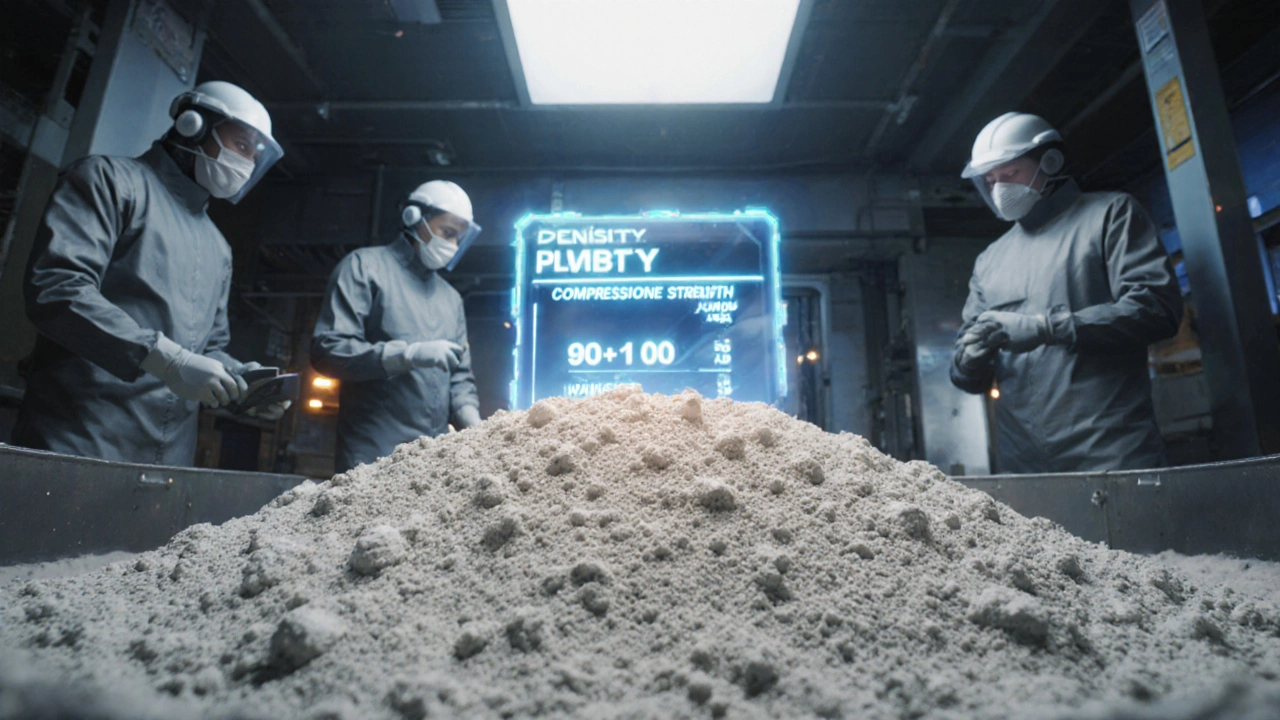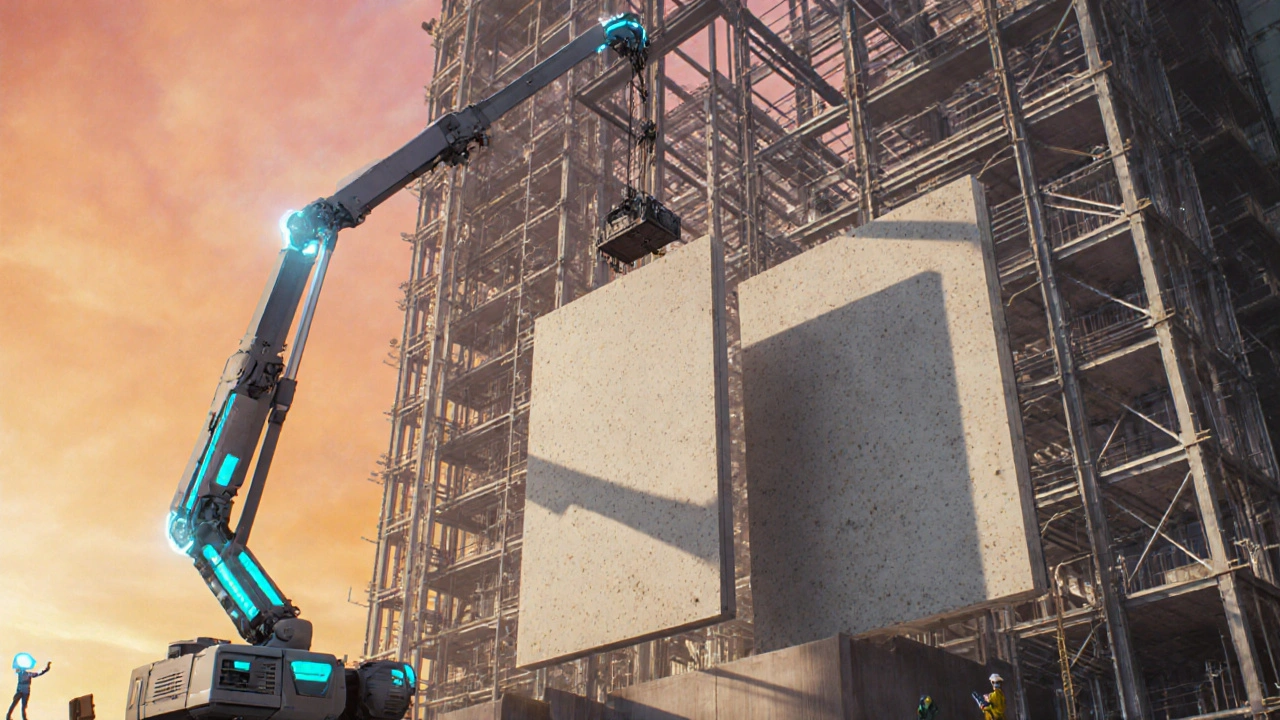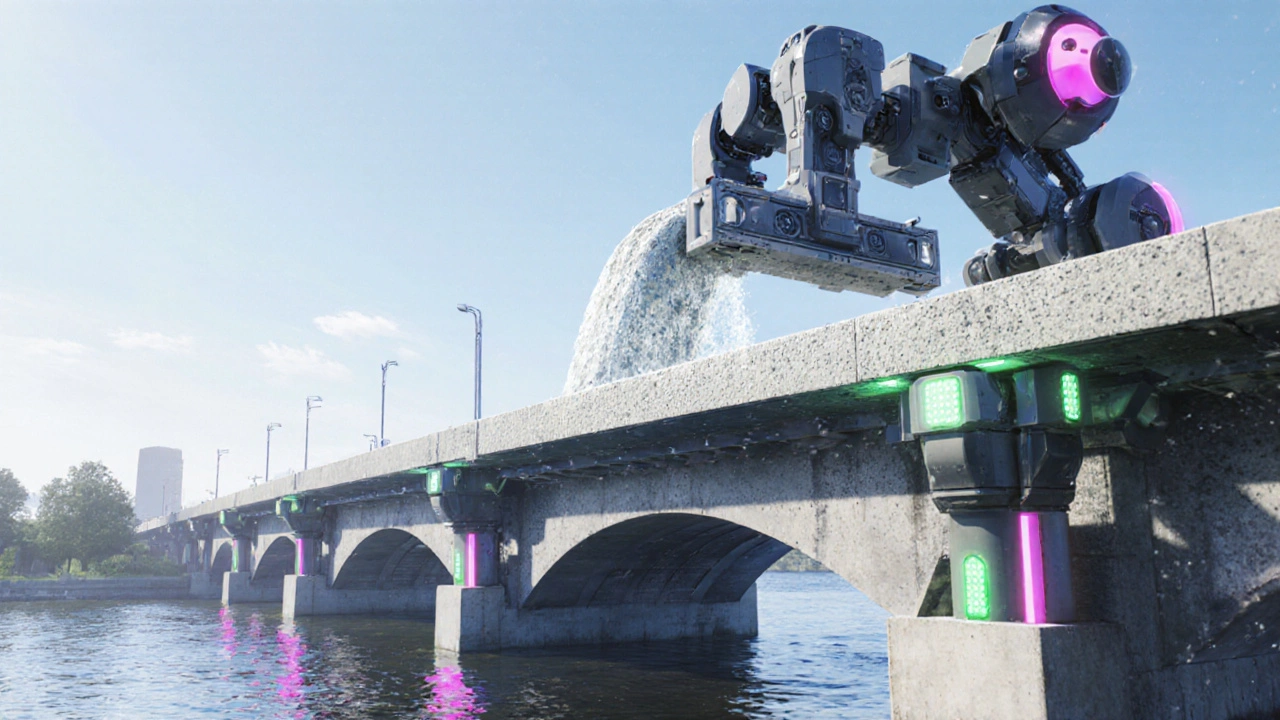 Oct, 19 2025
Oct, 19 2025
Low Density Concrete Weight Reduction Calculator
Results
Key Insight: For every 100 ft³ of structure, using low density concrete saves approximately 0 lb compared to normal concrete.
When engineers need a material that cuts weight without sacrificing strength, low density concrete is a light‑weight cementitious mix that incorporates low‑density aggregates or air‑entraining agents to reduce its mass. It’s not a new invention, but recent advances in mix design and production have opened up fresh opportunities across bridges, high‑rise buildings, and even underground tunnels.
What makes low density concrete different?
Traditional concrete typically weighs 150‑160 lb/ft³ (2400‑2400 kg/m³). By swapping out normal gravel for lightweight aggregates-expanded clay, shale, or pumice-the bulk density drops to 90‑110 lb/ft³ (1440‑1760 kg/m³). The reduced weight translates into smaller dead loads, which can lower foundation costs and enable longer spans.
Key ingredients and how they work
Three components drive the weight reduction:
- Lightweight aggregate materials like expanded perlite, vermiculite, or sintered fly ash that contain microscopic air pockets. Their internal voids replace solid rock, shaving off kilograms per cubic meter.
- Air‑entraining admixture chemical agents that trap tiny bubbles during mixing, creating a foam‑like structure. The bubbles act like micro‑sponges, further cutting density.
- Portland cement still provides the binding matrix, but the mix ratio is tweaked to keep workability low. The cement content is often reduced by 10‑15 % compared with normal concrete.
Innovative construction applications
Below are the most promising ways the industry is leveraging low density concrete today:
- Pre‑cast façade panels. The lighter panels can be lifted with smaller cranes, cutting rigging time by up to 30 % on a 20‑storey tower.
- Bridge deck overlays. A thinner overlay achieves the same load‑bearing capacity, extending service life without adding extra weight.
- Insulating concrete forms (ICFs). When combined with EPS inserts, the resulting wall system offers an R‑value of 20 + while staying structurally sound.
- Permeable pavement. Low density mixes with high air content allow water to flow through, reducing runoff in urban projects.
- Geotechnical backfill. The lighter mass eases compaction for deep excavations, especially in soft‑soil sites.

Comparing low density concrete with other lightweight options
| Property | Low density concrete | Conventional concrete | Autoclaved Aerated Concrete (AAC) |
|---|---|---|---|
| Typical density (lb/ft³) | 90‑110 | 150‑160 | 80‑100 |
| Compressive strength (MPa) | 30‑45 | 35‑55 | 10‑20 |
| Thermal conductivity (W/m·K) | 0.8‑1.2 | 1.7‑2.1 | 0.12‑0.16 |
| Typical use cases | Structural slabs, precast panels, backfill | Foundations, columns, general‑purpose slabs | Non‑load‑bearing walls, fire‑rated partitions |
| Cost per m³ (USD) | ≈ 85 | ≈ 100 | ≈ 120 |
While AAC excels at thermal insulation, low density concrete offers a stronger structural profile at a lower price point. This balance makes it the go‑to choice for projects that need both load‑bearing capacity and weight savings.
Design tips for engineers
- Target a 20‑30 % reduction in dead load when sizing foundations. Run a simple calculation: Reduced load = (original density - low‑density density) ÷ original density × 100 %.
- Keep the water‑to‑cement ratio below 0.45 to avoid excessive porosity that could compromise strength.
- Use a superplasticizer if workability drops; it lets you lower water content without making the mix too stiff.
- Perform a slump test at the job site; a slump of 50‑75 mm is typical for low density mixes.
- Consider adding micro‑fibers for crack resistance, especially in slab‑on‑grade applications.
Case study: Light‑weight bridge deck retrofit in Manchester
A 1990s‑era highway bridge over the River Irwell required a deck replacement. The original concrete slab weighed 150 lb/ft³, pushing the existing piers beyond their design limit. Engineers chose a low density concrete overlay with 8 % expanded shale aggregate. The new deck trimmed the dead load by 25 % while delivering a compressive strength of 38 MPa. Construction time fell from six weeks to four, and the project saved roughly £250,000 in foundation reinforcement costs.

Potential challenges and how to avoid them
Even with its benefits, low density concrete can stumble if you overlook a few details:
- Quality of aggregates. Poorly graded or contaminated lightweight aggregates can cause uneven strength distribution. Always source from certified suppliers.
- Moisture control. The air pockets can trap water, leading to delayed setting. Use a moisture‑meter before placing the mix.
- Fire resistance. Some lightweight mixes lose strength at high temperatures. Include fire‑retardant additives when using in fire‑exposed zones.
Future directions - where the market is heading
Three trends are shaping the next wave of low density concrete:
- Geopolymer binders. By swapping Portland cement for fly‑ash‑based geopolymer, carbon emissions drop by up to 70 % while retaining low density.
- 3‑D printing. Researchers are experimenting with foam‑stable mixes that can be extruded into complex shapes, opening up custom‑fit lightweight components.
- Recycled aggregates. Crushed concrete from demolition sites, when properly processed, can serve as a sustainable lightweight filler.
Adopting these innovations will keep low density concrete relevant in a climate‑conscious construction landscape.
Quick reference checklist
- Confirm target density (90‑110 lb/ft³).
- Select appropriate lightweight aggregate (expanded clay, perlite, etc.).
- Adjust water‑to‑cement ratio (≤ 0.45).
- Include a superplasticizer if slump < 50 mm.
- Run a trial batch and test compressive strength at 28 days.
What is the main advantage of low density concrete over normal concrete?
The key benefit is its reduced weight, which lessens dead loads on foundations and allows longer spans without extra reinforcement.
Can low density concrete be used for load‑bearing walls?
Yes, when designed for a compressive strength of 30 MPa or higher. It’s common in multi‑storey residential blocks where weight saving matters.
How does the cost of low density concrete compare to traditional concrete?
Material cost per cubic metre is typically 10‑15 % lower, but you may spend a bit more on specialized aggregates. Overall project cost usually drops because you need less steel and smaller foundations.
Is low density concrete suitable for freeze‑thaw environments?
Proper air‑entraining admixtures give it good resistance. Ensure the mix meets ASTM C666 for freeze‑thaw cycles.
What sustainability benefits does low density concrete offer?
Using lightweight aggregates often incorporates recycled industrial by‑products, reducing raw material extraction. The lighter structure also cuts transportation emissions.
Madhav Dasari
October 19, 2025 AT 14:47Wow, low‑density concrete sounds like a real game‑changer for us builders! 🎉 Imagine lifting those massive panels with a grin, thanks to lighter aggregates – it's practically magic. The weight savings alone can shave off tons of steel, which means faster builds and happier crews. And let’s not forget the environmental boost, reusing industrial by‑products while cutting down transport emissions. All in all, it’s a win‑win that makes our jobs not just easier, but also greener. 🚀
DHARMENDER BHATHAVAR
October 25, 2025 AT 09:41The reduced dead load directly translates to lower foundation costs.
Kevin Sheehan
October 31, 2025 AT 04:34From a philosophical standpoint, the very notion of “lightness” in construction challenges our traditional weight‑centric ideology. We cling to mass as a symbol of strength, yet here’s a material that proves otherwise. By embracing low‑density concrete, we confront entrenched norms and open the doors to more sustainable architecture. This isn’t just a technical tweak; it’s a paradigm shift demanding bold adoption. Let the industry resist, but the physics is indisputable.
Sunil Yathakula
November 5, 2025 AT 23:27yeah bro, the physics dont lie but u gotta watch those aggriates, if they ain't graded right the whole mix can wobble. also keep an eye on moisture, those tiny bubbles love to trap water and mess up setting times. overall tho, big props for pushing this tech forward!
Catherine Viola
November 11, 2025 AT 18:21It is imperative to recognize that the purported benefits of lightweight concrete are often overstated by industry lobbyists seeking to divert attention from deeper systemic issues. The integration of low‑density aggregates, while superficially advantageous, masks the underlying dependency on petrochemical‑based admixtures, whose production is far from benign. Moreover, the push for lighter structures conveniently aligns with a broader agenda to reduce labor costs, thereby eroding skilled trades. One must also consider the hidden environmental toll of mining and processing expanded shale, a process that releases significant quantities of greenhouse gases. In sum, the narrative of progress warrants rigorous scrutiny before wholesale adoption.
sravya rudraraju
November 17, 2025 AT 13:14In the context of contemporary construction practices, the adoption of low‑density concrete warrants a comprehensive examination that extends beyond mere weight reduction. Firstly, the selection of appropriate lightweight aggregates must be predicated on a meticulous analysis of their granulometry, porosity, and mineralogical composition, as these parameters directly influence both compressive strength and long‑term durability. Secondly, the entrained air content, while beneficial for freeze‑thaw resistance, necessitates precise control via calibrated admixture dosing; excessive air can precipitate premature carbonation and compromise structural integrity. Thirdly, the water‑to‑cement ratio must be rigorously monitored, ensuring it remains below the threshold of 0.45 to mitigate undue porosity, which could otherwise diminish the concrete’s load‑bearing capacity. Fourth, the incorporation of superplasticizers can offset workability challenges introduced by reduced water content, thereby preserving the desired slump range of 50‑75 mm. Fifth, it is incumbent upon engineers to conduct trial mixes, applying statistical process control to verify that target densities of 90‑110 lb/ft³ are consistently achieved across batch variations. Sixth, micro‑fibers, when judiciously added, enhance crack arrestment, particularly in slab‑on‑grade applications subject to tensile stresses. Seventh, quality assurance protocols should encompass moisture measurement prior to placement, employing calibrated meters to preempt setting delays caused by trapped water within the aggregate matrix. Eighth, fire‑resistance considerations must be addressed through the integration of appropriate retardants, especially for applications in high‑rise buildings where regulatory compliance is stringent. Ninth, life‑cycle cost analyses reveal that notwithstanding marginally higher material expenses, the overall project economics can improve due to reductions in foundation dimensions and steel reinforcement. Tenth, the environmental footprint is favorably impacted by the utilization of recycled industrial by‑products as lightweight aggregates, thereby curtailing virgin resource extraction. Eleventh, the synergy between low‑density concrete and insulating concrete forms (ICFs) presents an avenue for achieving superior thermal performance without sacrificing structural robustness. Twelfth, ongoing research into geopolymer binders promises to further diminish the carbon intensity of such mixes, aligning with global sustainability targets. Thirteenth, it is advisable to engage with certified suppliers who adhere to ISO‑9001 standards to guarantee aggregate consistency. Fourteenth, documentation of all mix design parameters should be maintained in a digital repository to facilitate future audits and knowledge transfer. Finally, continuous professional development, through attendance at workshops and seminars on innovative concrete technologies, ensures that practitioners remain at the forefront of industry advancements, thereby delivering safer, more efficient, and environmentally responsible structures.
Ben Bathgate
November 23, 2025 AT 08:07Look, the hype around low‑density concrete is overblown. Sure, it’s lighter, but you trade off a lot of strength and durability. Most of the time you end up with a product that looks good on paper but fails under real‑world loads. Engineers should stick to proven materials unless you really need that marginal weight saving.
Caroline Keller
November 29, 2025 AT 03:01oh wow another "miracle" material to save the world... 🙄
dennis turcios
December 4, 2025 AT 21:54Honestly, the whole thing feels like a marketing gimmick. Some projects might benefit, but the majority of builds won’t see significant gains, and the added complexity could offset any cost savings.